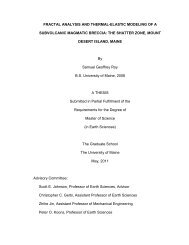Exploring the Methods of Differential Calculus through the ...
Exploring the Methods of Differential Calculus through the ...
Exploring the Methods of Differential Calculus through the ...
Create successful ePaper yourself
Turn your PDF publications into a flip-book with our unique Google optimized e-Paper software.
Figure 7. Speed curves for <strong>the</strong> three candidate ramps.<br />
The concave up curve starts out with <strong>the</strong> highest speed but <strong>the</strong> speed declines and it ends with <strong>the</strong><br />
lowest speed. On <strong>the</strong> straight line, <strong>the</strong> speed is constant. The concave up curve starts with <strong>the</strong><br />
slowest speed, but <strong>the</strong> speed increases and it ends with <strong>the</strong> highest speed. There is a point in this<br />
graph at which <strong>the</strong> curves <strong>of</strong> <strong>the</strong> first and third candidates intersect, meaning that <strong>the</strong>y have <strong>the</strong><br />
same speed at that instant. Also at that point <strong>the</strong> speed <strong>of</strong> candidate two is higher than that <strong>of</strong><br />
candidate one and three. These intersections correspond precisely to <strong>the</strong> intersections <strong>of</strong> <strong>the</strong><br />
velocity curves.<br />
After <strong>the</strong> three speeds are compared <strong>the</strong> final step is to find <strong>the</strong> second derivatives <strong>of</strong> each<br />
candidate ramp, representing <strong>the</strong> acceleration curve <strong>of</strong> <strong>the</strong> candidate ramps. The acceleration<br />
curves are calculated and shown graphically in Figure 8.<br />
Candidate Ramp One:<br />
Candidate Ramp Two:<br />
Candidate Ramp Three:
















